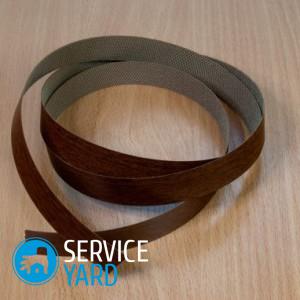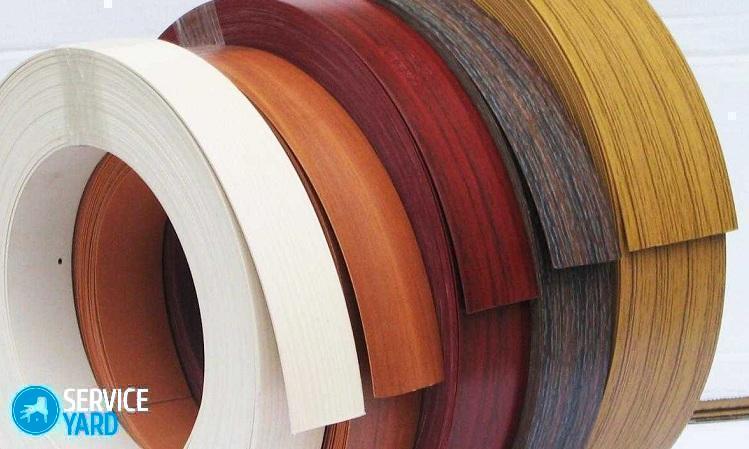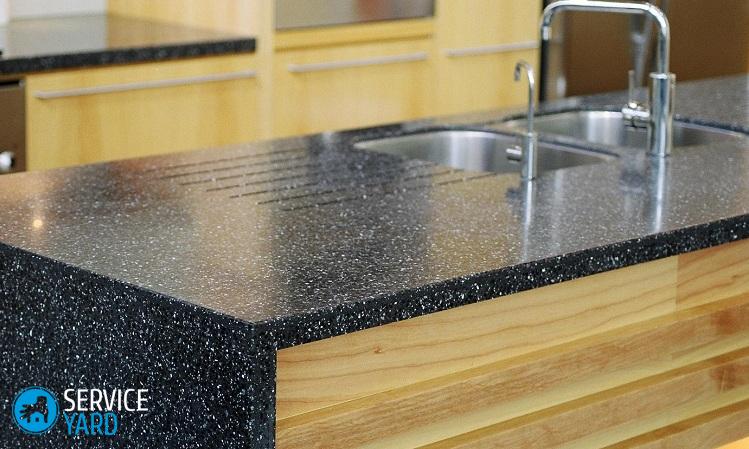Edge for tabletops with glue - how to glue?

For furniture made of laminated particleboard, the edges without processing do not look very aesthetically pleasing. In addition, the formaldehyde resin that holds the chips together in the stove can become a source of harmful fumes. To avoid these problems, use a special furniture profile or edge. For gluing the edges, special equipment is usually used, but you can also cope with this task yourself at home. So, the edge for the countertop with glue - how to glue? We’ll talk about this.
to contents ↑Types of furniture edges
Chipboard is one of the most common materials in furniture production. The furniture edge is designed to mask the cuts formed after cutting the necessary parts. For the manufacture of decorative strips, various edges are used. They are made from different materials. Their properties and price are also different. Before gluing the edge to the countertop, consider the main varieties of materials.
Melamine paper
Melamine impregnated paper edge is the cheapest option. For its manufacture, thick paper is used, impregnated with melamine and coated with varnish. For ease of edging, an adhesive coating is applied to the back of the film. Working with the material is extremely simple: you need to heat it up and press it well against the furniture end.
Important! A paper edge is not only the cheapest, but also the most short-lived kind of finish.
The most common thickness of paper tape is 0.2 and 0.4 mm. It makes no sense to use a thicker edge, and the price will increase significantly.
Important! Paper tapes bend well, do not break, but their mechanical strength is extremely low. For this reason, the paper edge is used on the back of a shelf or countertop - where there is no heavy load.
PVC
Durable and practical polyvinyl chloride (PVC) is also used in furniture production. A tape is formed from a polymer mass dyed in one color or another. The front surface can be smooth or textured (imitation wood fibers). There are so many color options that you can choose the right one without any difficulties. At the same time, the price of PVC is more than affordable.
Sticking PVC is very simple, so home craftsmen often use it. You can achieve a good result with the help of simple devices. The benefits of PVC tape include:
- High strength.
- Moisture resistance.
- Chemical neutrality to household chemicals.
The thickness of the furniture edge is 0.4-4.0 mm, with a width of 19-54 mm. There are tapes with or without adhesive.
Important! Polyvinyl chloride also has a significant minus: a not very wide range of operating temperatures (-5 - +45 degrees). Therefore, in the winter, furniture can not be left on the street for a long time (for example, when moving). Care must also be taken when heating the material before gluing so that it does not melt.
ABS (ABC) plastic
This is an environmentally friendly material that does not contain harmful impurities. It is durable and practical, resistant to significant temperature extremes. He has one drawback - a relatively high cost.
Important! ABC tape can be matte, semi-gloss or glossy. There is a furniture tape that imitates various types of wood.
Veneer
It is the finest wood cut processed and shaped like a ribbon. It is used for finishing edges of veneer products.The material is not cheap and quite difficult to use. Sticking this material requires certain skills, so it is advisable to contact the masters.
Acrylic
A pattern is applied on the back strip of the tape, and a transparent acrylic layer creates a three-dimensional effect. Therefore, it is also known as 3D. This option is suitable for furniture with an original design.
Profiles
In addition to the edges, a special profile of a T-shaped or U-shaped section is used for furniture decoration. For T-profiles, a groove is formed in the edge. The profile itself is hammered into the groove with a mallet. There are 14 and 16 mm profiles made of plastic or aluminum. Installation of a profile with a U-shaped section is carried out on special glue.
to contents ↑Important! The disadvantage of this type of finish is that they are unsuitable for curved surfaces.
How to stick the edge on the countertop with your own hands?
There are 2 ways of gluing:
- The first relates to materials with a bonded adhesive.
- The second concerns gluing tapes without an adhesive layer.
Important! In the latter case, they acquire universal glue that glues edging, wood and plastic equally well.
Now about what thickness material to choose. According to the canons of GOST, edges that are not visible can not be processed. But it’s better not to be lazy and to slice off all the slices. This is necessary to avoid the absorption of moisture from the particleboard and the evaporation of formaldehyde:
- To process inconspicuous areas, a PVC tape with a thickness of 0.4 mm is used.
- On the “front” edges, a 2 mm thick PVC tape is used.
- For shelves - 1 mm.
Self-adhesive tape
Start working with thin edges. First, consider the installation of melamine or PVC tape. Let's consider how to glue an edge on a chipboard with an iron. To do this, you will need scissors and a regular iron with a fluoroplastic nozzle. The procedure is as follows:
- Cut a piece of tape with a margin of 1.5-2.0 cm.
- Put the iron on the “two”.
- Attach the edge to the work surface, smooth so that small pieces hang on the edges.
- Iron the tape with the iron through the nozzle. If there is no nozzle, you can use soft textiles.
- After the edge has dried, trim the edges. To make them look as even as possible, process them with a hand mill.
Important! Trim the edges with maximum accuracy. The material is thin, all defects are very noticeable.
PVC tape without adhesive
To stick a PVC tape without a special layer, you will need a universal adhesive for the PVC edge to the furniture (for example, “Moment”) and a piece of soft textile:
- Remember to read the glue manual first.
- Now apply glue to the tape, wait for the time specified in the instructions, then connect the glued surfaces.
- To press the surfaces more firmly, use a wooden block or soft cloth.
- Press the tape with stroking movements so that the adhesion is better.
- After the glue completely hardens, you can align the edges.
Stock footage







There are no special difficulties in fixing up the cuts of furniture. The main thing is to choose the best version of the material and apply it correctly, and now you know how to do it, thanks to this review.
- How to choose a vacuum cleaner taking into account the characteristics of the house and coatings?
- What to look for when choosing a water delivery
- How to quickly create comfort at home - tips for housewives
- How to choose the perfect TV - useful tips
- What to look for when choosing blinds
- What should be running shoes?
- What useful things can you buy in a hardware store
- Iphone 11 pro max review
- Than iPhone is better than Android smartphones




Report typo
Text to be sent to our editors: